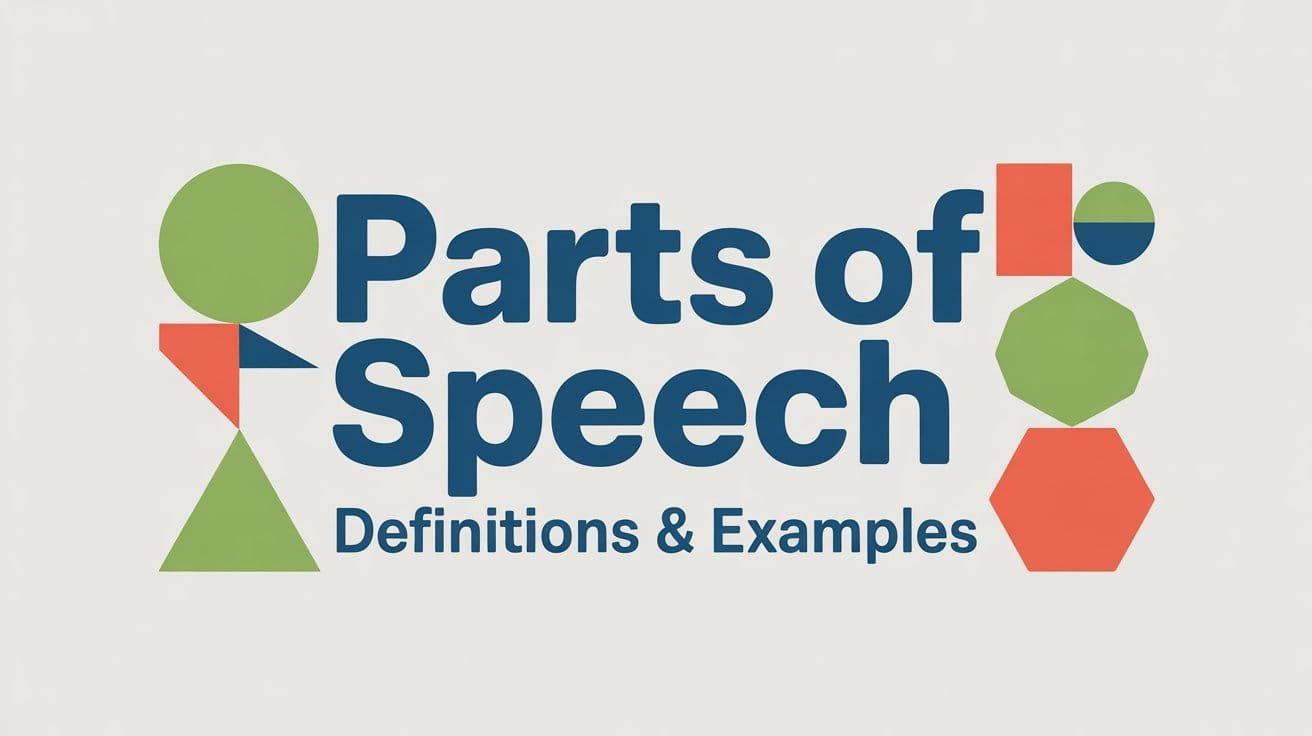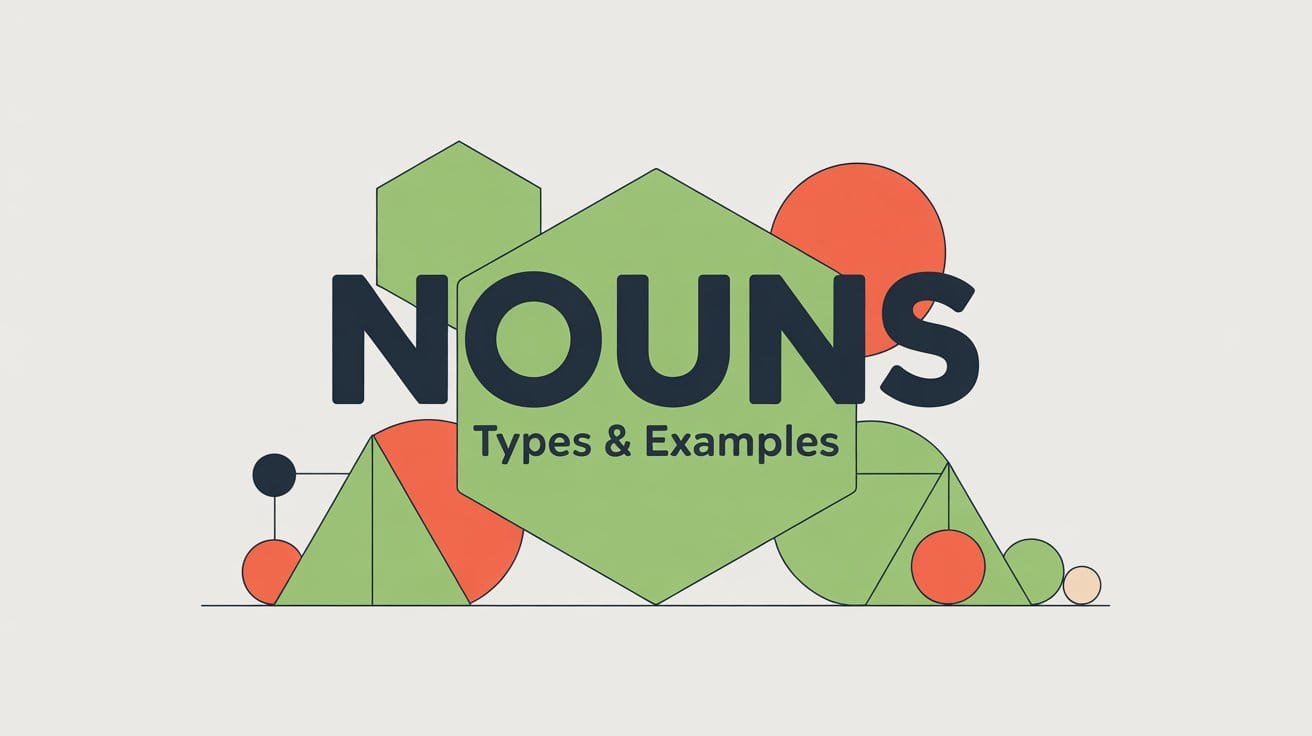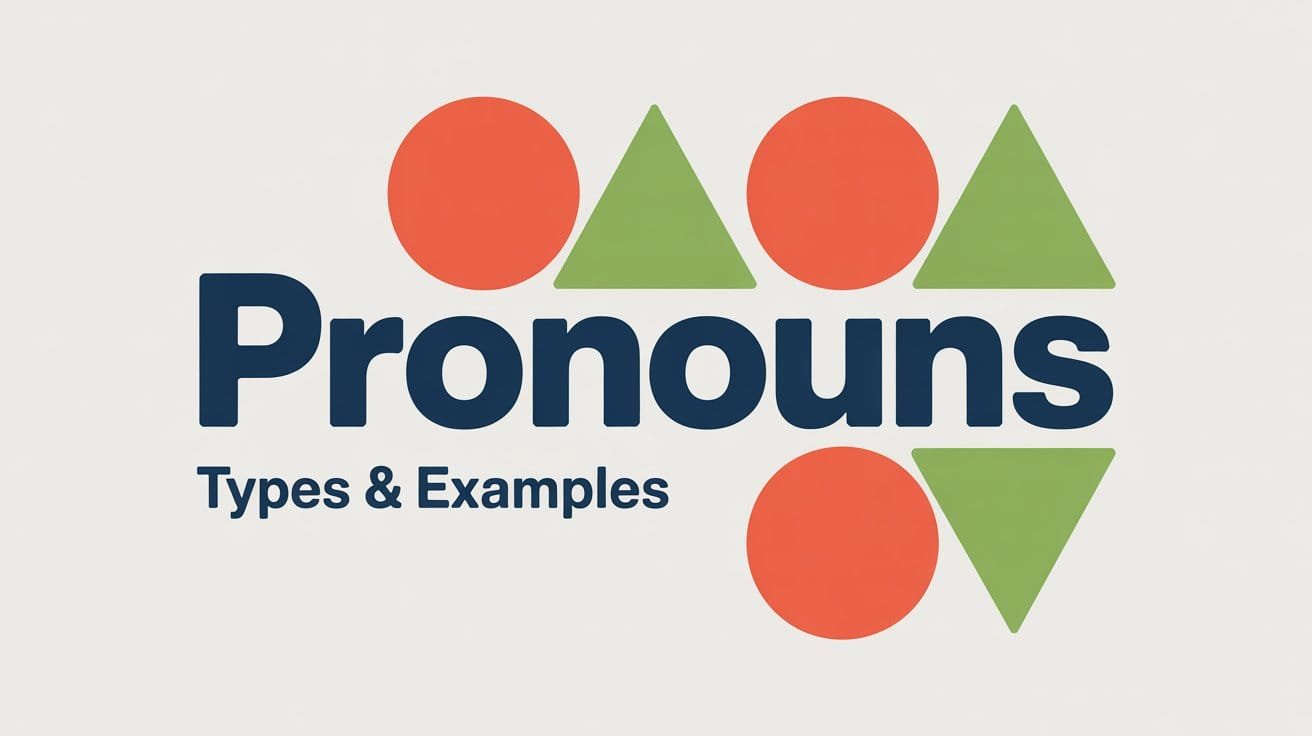Each word in a sentence serves a specific function. Some name things, others describe, show action, or connect ideas. These functions are grouped into eight categories called parts of speech.
In this guide, you’ll explore all eight parts of speech with clear explanations and useful examples. You’ll also learn how to spot them in sentences and understand how one word can take on different roles depending on its use.
What Are the Parts of Speech in English?
In English grammar, parts of speech are the basic categories that describe how words function in a sentence. Each part of speech has a different job. Some words name people or things, others show actions, describe qualities, or connect ideas.
There are eight traditional parts of speech in English:
- Nouns
- Pronouns
- Verbs
- Adjectives
- Adverbs
- Prepositions
- Conjunctions
- Interjections
Every word you use falls into one of these categories based on how it’s used. For example, the word “light” can be a noun (“The light is bright”), an adjective (“a light jacket”), or a verb (“They light the candles”); its role depends on the sentence.
Nouns
A noun is a word that names a person, place, thing, or idea. Nouns are often the subject of a sentence, but they can also act as objects, complements, or objects of a preposition.
Types of Nouns
While all nouns name something, they can be grouped into different types:
- Common nouns refer to general names: teacher, river, phone
- Proper nouns name specific people or places and are capitalized: India, Maria, Amazon
- Abstract nouns name ideas or feelings: honesty, fear, friendship
- Collective nouns refer to groups: team, family, flock
Examples in Sentences
- The teacher explained the topic clearly. (common noun)
- Sarah moved to Canada last year. (proper noun)
- We believe in honesty and hard work. (abstract noun)
- The team won the final match. (collective noun)
Nouns often work with articles (a, an, the) and can be singular or plural, depending on the context.
Pronouns
A pronoun is a word that takes the place of a noun. Pronouns help avoid repetition and make sentences easier to read or say. Instead of repeating the noun every time, a pronoun can be used once the noun is known.
Types of Pronouns
There are several kinds of pronouns, each serving a specific function:
- Personal pronouns: I, you, he, she, it, we, they
- Possessive pronouns: mine, yours, his, hers, ours, theirs
- Reflexive pronouns: myself, yourself, themselves
- Demonstrative pronouns: this, that, these, those
- Relative pronouns: who, whom, which, that
- Indefinite pronouns: someone, anyone, everything, few
Examples in Sentences
- He called just a minute ago. (personal pronoun)
- This is my favorite book. (demonstrative pronoun)
- She taught herself how to play guitar. (reflexive pronoun)
- The girl who won the contest is my cousin. (relative pronoun)
- Everyone was invited to the meeting. (indefinite pronoun)
Pronouns must match the noun they replace in number (singular/plural) and gender, when necessary.
Verbs
A verb shows action or describes a state of being. It’s the part of the sentence that tells what the subject does or what condition it’s in. Without a verb, a sentence can’t function.
Types of Verbs
Verbs fall into different categories based on how they work:
- Action verbs express physical or mental actions: run, think, eat
- Linking verbs connect the subject to more information: be, seem, become
- Helping verbs work with main verbs to show tense or voice: have, is, will, can
Verbs can also be:
- Transitive (followed by a direct object): She wrote a letter.
- Intransitive (no direct object): He sleeps peacefully.
Examples in Sentences
- They built a new fence last weekend. (action verb)
- The soup smells delicious. (linking verb)
- She has finished her assignment. (helping + main verb)
- I ran five kilometers this morning. (intransitive use)
- He kicked the ball hard. (transitive use)
Understanding verbs also helps when learning verb tenses, subject-verb agreement, and voice.
Adjectives
An adjective is a word that describes or modifies a noun or pronoun. It gives more detail about a person, place, thing, or idea, such as how many, which one, or what kind.
What Do Adjectives Do?
Adjectives answer questions like:
- What kind? (blue shirt, loud noise)
- How many? (three books, several chances)
- Which one? (this bag, last cookie)
Types of Adjectives
- Descriptive adjectives: tall, friendly, sharp
- Demonstrative adjectives: this, that, these, those
- Interrogative adjectives: which, what, whose
- Possessive adjectives: my, your, their
Examples in Sentences
- They live in a quiet neighborhood. (descriptive adjective)
- Can you pass me that notebook? (demonstrative adjective)
- He scored three goals in the match. (number adjective)
- She forgot her keys at home. (possessive adjective)
- Which road leads to the lake? (interrogative adjective)
Adjectives usually come before the noun, but they can also follow linking verbs: The sky is clear.
Adverbs
An adverb is a word that modifies a verb, adjective, or another adverb. It adds detail about how, when, where, or to what extent something happens.
What Do Adverbs Describe?
Adverbs can answer:
- How? (gently, quickly, clearly)
- When? (yesterday, soon, always)
- Where? (outside, here, nearby)
- To what extent? (completely, barely, very)
Not all adverbs end in -ly, though many do. Words like often, fast, and almost are also adverbs.
Examples in Sentences
- She speaks clearly during presentations. (modifies a verb)
- It’s a very hot day. (modifies an adjective)
- They arrived too early. (modifies another adverb)
- We’ll leave soon after lunch. (modifies a verb)
- The cat sat quietly in the corner. (modifies a verb)
Adverbs are flexible and can appear at the beginning, middle, or end of a sentence, depending on what they describe.
Prepositions
A preposition is a word that shows the relationship between a noun (or pronoun) and another word in the sentence. It often indicates location, direction, time, or cause.
A preposition is always followed by a noun or pronoun, forming a prepositional phrase (e.g., on the table, after the game).
What Do Prepositions Show?
- Location: under the bed, at the station
- Direction: into the room, toward the exit
- Time: before dinner, during the meeting
- Cause or method: because of rain, by train
Examples in Sentences
- The keys are on the table. (location)
- She walked through the tunnel. (direction)
- We’ll meet after the class. (time)
- He succeeded because of his determination. (cause)
- They traveled by car. (method)
Some common prepositions include: in, on, at, by, for, to, with, from, about, over, under, during, and through.
Conjunctions
A conjunction is a word that connects words, phrases, or clauses. It helps join parts of a sentence so ideas flow clearly and logically.
Types of Conjunctions
- Coordinating conjunctions: Connect equal parts (words, phrases, or independent clauses).
Common ones: for, and, nor, but, or, yet, so (remembered with the acronym FANBOYS) - Subordinating conjunctions: Connect a dependent clause to an independent clause.
Examples: because, although, while, if, unless, since, before, after - Correlative conjunctions: Work in pairs to connect balanced ideas.
Examples: either…or, neither…nor, both…and, not only…but also
Examples in Sentences
- I wanted to go out, but it started raining. (coordinating)
- We’ll leave after the meeting ends. (subordinating)
- Neither the manager nor the assistant was available. (correlative)
- She can come if she finishes her work. (subordinating)
Using conjunctions properly helps you combine ideas without making your writing choppy or confusing.
Interjections
An interjection is a word or short phrase that expresses a sudden emotion or reaction. Interjections often stand alone and are typically found at the beginning of a sentence. They’re commonly used in conversation and informal writing.
They can express:
- Surprise: Wow! Oh no!
- Joy: Yay! Hooray!
- Disapproval: Ugh! Ew!
- Pain or distress: Ouch! Ow!
- Agreement or hesitation: Yes, No, Hmm, Well
Examples in Sentences
- Wow! That was an incredible performance.
- Oops, I forgot to attach the file.
- Hey, are you coming with us?
- Ugh! I can’t believe I missed the bus again.
- Well, I guess that makes sense.
Most interjections are followed by an exclamation mark or a comma, depending on the tone or strength of the feeling.
Words That Belong to More Than One Part of Speech
Some words in English can function as more than one part of speech, depending on how they’re used in a sentence. This flexibility often confuses learners, but recognizing the word’s role in context makes it easier to understand.
Examples in Different Roles
- Light
- Noun: The light is too bright in this room.
- Adjective: She wore a light jacket in the spring.
- Verb: They light the candles every evening.
- Run
- Verb: He runs five miles every day.
- Noun: She went for a run before breakfast.
- Fast
- Adjective: It’s a fast car.
- Adverb: He drives fast on the highway.
How to Identify Parts of Speech in a Sentence
To figure out what part of speech a word is, look at how it functions within the sentence, not just the word itself. The same word can play different roles depending on its use.
Steps to Identify the Part of Speech
- Find the sentence’s subject and verb first
These are usually a noun or a pronoun and a verb. - Look at what each word is doing
Ask questions like:- Is it naming something? (noun)
- Is it replacing a noun? (pronoun)
- Is it describing something? (adjective/adverb)
- Is it showing action or state? (verb)
- Is it connecting ideas? (conjunction)
- Is it showing position or time? (preposition)
- Is it expressing a feeling? (interjection)
- Use sentence structure clues
Placement often helps. Adjectives typically appear before nouns. Adverbs may follow verbs or come before adjectives.
Example
Sentence: She quickly opened the old book.
- She → pronoun (replaces a noun as the subject)
- quickly → adverb (describes how she opened)
- opened → verb (action)
- the → article (a type of determiner, often grouped with adjectives)
- old → adjective (describes the book)
- book → noun (thing)
Parts of Speech Table (Summary Chart)
This table gives you a quick overview of the eight parts of speech, including what each one does and an example to help you recognize it in context.
| Part of Speech | Function | Example |
|---|---|---|
| Noun | Names a person, place, thing, or idea | She adopted a dog. |
| Pronoun | Replaces a noun | They are arriving soon. |
| Verb | Shows action or state of being | He wrote a message. |
| Adjective | Describes a noun or pronoun | It was a cold morning. |
| Adverb | Describes a verb, adjective, or another adverb | She ran quickly. |
| Preposition | Shows relationship between words (time, place) | The bag is under the table. |
| Conjunction | Connects words, phrases, or clauses | I wanted tea, but had coffee. |
| Interjection | Expresses emotion or reaction | Wow! That’s amazing. |
FAQs About Parts of Speech
What are the 8 parts of speech in English?
The eight parts of speech are: noun, pronoun, verb, adjective, adverb, preposition, conjunction, and interjection. Each plays a specific role in how a sentence is formed and understood.
Can a word belong to more than one part of speech?
Yes. Many words can function differently depending on the sentence. For example, “light” can be a noun (“Turn on the light”), an adjective (“a light bag”), or a verb (“They light the candles”).
How can I tell what part of speech a word is?
Look at how the word functions in the sentence. Ask yourself what it’s doing: Is it naming something, describing something, showing action, or connecting ideas? Context is key.
Are articles like “a,” “an,” and “the” a part of speech?
Yes, they are often grouped with adjectives or considered determiners, which describe or limit nouns. While not always listed among the traditional eight, they play an essential grammatical role.



